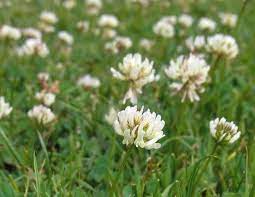No products in the cart.

Discover the Benefits of White Clover | Uses, Growing Tips & More
All About White Clover: Nature’s Tiny Treasures
Introduction
Welcome to the world of white clover! Have you ever noticed those small, delicate flowers sprinkled across lawns and meadows? They might seem like just another pretty bloom, but white clover (Trifolium repens) holds much more significance than meets the eye. In this article, we’ll delve into the fascinating world of white clover, exploring its benefits, uses, and why it’s more than just a common weed.

Table of Contents
| Sr# | Headings |
|---|---|
| 1 | What is White Clover? |
| 2 | History and Cultural Significance |
| 3 | Where Does White Clover Grow? |
| 4 | Identification and Characteristics |
| 5 | Benefits of White Clover |
| 6 | Uses in Agriculture and Gardening |
| 7 | White Clover as a Green Manure |
| 8 | Wildlife and White Clover |
| 9 | Common Myths About White Clover |
| 10 | How to Grow White -Clover |
| 11 | Potential Drawbacks |
| 12 | Harvesting and Storing White -Clover |
| 13 | White- Clover and Sustainability |
| 14 | Conclusion |
| 15 | FAQs (Frequently Asked Questions) |
What is White Clover?
White -clover (Trifolium repens) is a low-growing perennial plant native to Europe, Asia, and North Africa. It belongs to the legume family, Fabaceae, which includes peas and beans. The plant is characterized by its trifoliate leaves and small, white flowers arranged in clusters.
History and Cultural Significance
Throughout history, white -clover has been revered for its medicinal properties and use as a forage crop. It has also been associated with luck and prosperity in various cultures, especially in Celtic traditions where it symbolized the triple goddess and was thought to ward off evil spirits.
Where Does White- Clover Grow?
White -clover thrives in temperate and sub-tropical climates and is commonly found in lawns, meadows, and pastures. It prefers well-drained soils and is often used as a ground cover to prevent soil erosion.
Identification and Characteristics
Identifying white- clover is relatively easy due to its distinctive trifoliate leaves and small, white flower heads. The plant forms dense mats, making it a popular choice for ground cover in gardens and landscaping.
Benefits of White -Clover
White -clover offers a range of benefits, including nitrogen fixation, which improves soil fertility naturally. It attracts pollinators and beneficial insects, enhances biodiversity, and requires minimal maintenance compared to traditional lawns.
Uses in Agriculture and Gardening
In agriculture, white- clover is utilized as a forage crop for livestock and as a cover crop to suppress weeds and improve soil health. In gardening, it’s often used as a ground cover to attract bees and other pollinators.
White- Clover as a Green Manure
White- clover serves as an excellent green manure, enriching the soil with nitrogen and organic matter. Its deep root system also helps improve soil structure and water retention.
Wildlife and White- Clover
White- clover supports a variety of wildlife, including bees, butterflies, and small mammals. It provides a food source and habitat, contributing to local ecosystems and biodiversity.
Common Myths About White- Clover
Contrary to popular belief, white -clover is not just a weed but a beneficial plant with multiple uses. It does not kill grass but complements it, creating a lush, green lawn.
How to Grow White- Clover
Growing white- clover is easy and requires minimal effort. It can be sown directly into the soil or mixed with grass seed. Regular mowing helps maintain a healthy stand.
Potential Drawbacks
While beneficial, white -clover can be invasive in some regions. It spreads quickly and may compete with other plants in certain environments.
Harvesting and Storing White -Clover
Harvesting white- clover can be done by hand or with a scythe. It can be dried for use as hay or green manure, stored in a cool, dry place.
White -Clover and Sustainability
White- clover promotes sustainability by reducing the need for chemical fertilizers and pesticides. It improves soil health and supports biodiversity, making it an eco-friendly choice for gardens and farms.
Conclusion
In conclusion, white -clover is more than just a pretty flower—it’s a powerhouse of benefits for your garden, lawn, and the environment. Whether you’re looking to attract pollinators, improve soil fertility, or create a sustainable landscape, white- clover is an excellent choice.
FAQs (Frequently Asked Questions)
Is white clover good for lawns?
Yes, white clover is excellent for lawns. It’s low-maintenance, attracts pollinators, and enriches the soil naturally.
Can white clover kill grass?
No, white clover does not kill grass. In fact, it complements grass by adding nitrogen to the soil and creating a lush, green lawn.
How do you get rid of white clover?
You can control white clover manually by hand weeding or using a broadleaf herbicide, although chemical options should be used judiciously.
Does white clover attract bees?
Yes, white clover is a favorite among bees and other pollinators due to its nectar-rich flowers.
Is white clover edible?
Yes, white clover is edible and has been used in salads and teas. Ensure the area is free from pesticides if harvesting for consumption.
IN HINDI
Go and turn on towards organic farming to save future and thire save childs:
Elevate Plant Growth with Premium Bone Powder – Buy Now!
Organic Cow Dung Compost: Transform Your Garden Naturally
Premium Humic Acid for Healthy Plants | Enhance Soil & Boost Growth
Boost Plant Growth Naturally with Mustard Cake | Organic Fertilizer
Transform Your Garden with NPK Fertilizer | Boost Growth by 30%
Premium Perlite for Enhanced Gardening | Buy Now
Live Earthworms with Enhance Your Garden (soil health)
1 Neem Khali: Unveiling the Wonders of Nature
1Transform your garden with vermiwash-buy now
1 Premium quality Vermicompost [ केचुआ खाद ]
Follow us:
Tagged Inwhite clover


